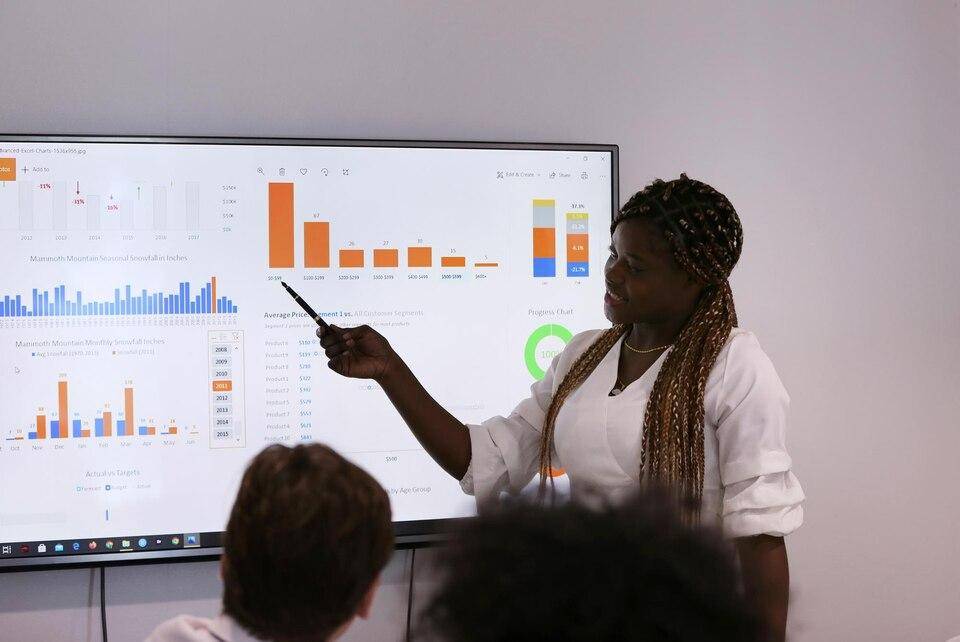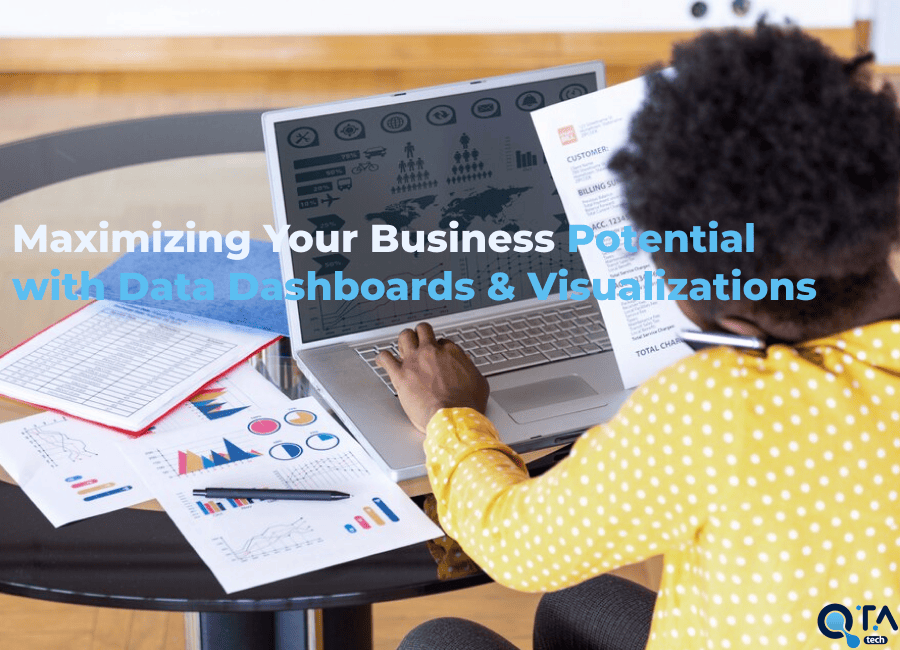Maximizing Your Business Potential with Data Dashboards & Visualizations
In today's data-driven world, organizations are drowning in a sea of information. To make sense of this vast amount of data, businesses are turning to data dashboards and visualizations. These tools not only simplify data analysis but also provide valuable insights that can drive informed decision-making. In this article, we'll explore the benefits of using data dashboards and visualizations, how to create effective ones to drive business success. Whether you're a business owner, manager, or analyst, this article will provide you with the knowledge and tools you need to unleash the power of data dashboards and visualizations. in your organization. With the help of this article, you'll be able to identify key performance indicators, track progress towards goals, and make data-driven decisions with confidence. Additionally, you'll learn how to present complex data in a clear and concise manner that is easy for stakeholders to understand and act upon.
What are data dashboards and visualizations ?
Data dashboards and visualizations are tools used to display and analyze data in a visual format. They allow businesses to quickly and easily understand complex data sets, identify trends, and make informed decisions. Data dashboards typically consist of a collection of charts, graphs, and other visual representations of data, while visualizations can include anything from maps to interactive graphics. By presenting data clearly and concisely, data dashboards and visualizations can help businesses identify areas for improvement, track progress, and make data-driven decisions.
Identify your key performance indicators (KPIs).
Before creating a data dashboard or visualization, it's important to identify your key performance indicators (KPIs). KPIs are specific metrics that are used to measure the success of your business. They can vary depending on your industry, business goals, and objectives. For example, if you're running an e-commerce business, your KPIs might include website traffic, conversion rates, and average order value. Once you've identified your KPIs, you can use them to create a data dashboard or visualization that provides a clear and concise overview of your business performance.
How data dashboards and visualizations work to make complex data sets more easily understandable?
Data dashboards and visualizations work by presenting complex data sets in a visual format that is easier to understand and interpret. Instead of sifting through spreadsheets or tables of data, businesses can quickly identify trends and patterns through the use of charts, graphs, and other visual representations. This not only saves time but also helps to reduce the likelihood of errors or misinterpretations of data. By using data dashboards and visualizations, businesses can gain valuable insights into their operations and make data-driven decisions that can lead to improved performance and increased profitability.
However, it is important to note that data dashboards and visualizations may not always be effective in all situations. For example, if the data being presented is too simplistic or lacks context, the visualizations may not provide any meaningful insights. Additionally, if the data being used to create the visualizations is inaccurate or incomplete, the resulting insights may be misleading or incorrect. Therefore, it is important to carefully evaluate and validate the data being used before relying on data dashboards and visualizations for decision-making
Examples of different types of visual representations, such as maps and interactive graphics.
Some examples of visual representations that can be used in data dashboards include heat maps, scatter plots, pie charts, and line graphs. Interactive graphics, such as clickable maps and drill-down charts, allow users to explore data in more detail and gain deeper insights. These visualizations can be customized to fit the specific needs of a business, making it easier to track progress and identify areas for improvement. Overall, data dashboards and visualizations are powerful tools that can help businesses make more informed decisions and achieve their goals.

For example, a retail business can use a data dashboard to track sales by region and product category. They can use a heat map to quickly identify areas where sales are strong or weak, and a scatter plot to see if there are any correlations between sales and factors such as advertising spend or weather patterns. They can also use interactive graphics, such as clickable maps, to drill down into specific regions or stores and gain more detailed insights. This information can be used to adjust pricing strategies, allocate resources more effectively
The importance of identifying KPIs when creating a data dashboard or visualization
One crucial aspect of creating a data dashboard or visualization is identifying the key performance indicators (KPIs) that are most relevant to the business. KPIs are specific metrics that measure the success of a particular aspect of the business, such as sales, customer satisfaction, or website traffic. By identifying and tracking these KPIs, businesses can gain a better understanding of their performance and make data-driven decisions to improve it. For example, a KPI for a retail business might be the conversion rate of website visitors to customers. By tracking this KPI over time, the business can identify trends and make adjustments to their website or marketing strategies to improve the conversion rate. Similarly, a KPI for a customer service department might be the average response time to customer inquiries. By tracking this KPI, the department can identify areas where they may be falling short and make changes to improve their response time. Overall, identifying and tracking KPIs is essential for businesses to make informed decisions and optimize their performance.
Common mistakes to avoid when designing a data dashboard or visualization
When designing a data dashboard or visualization, it's important to avoid common mistakes that can hinder its effectiveness. One mistake is creating a cluttered or confusing layout, which can make it difficult for users to understand and interpret the data. Another mistake is including too much information or irrelevant data, which can overwhelm users and make it harder to identify key insights. Additionally, it's important to ensure that the dashboard or visualization is user-friendly and easy to navigate, with clear labels and intuitive design. By avoiding these common mistakes, businesses can create data dashboards and visualizations that effectively communicate insights and drive informed decision making.
For example, a company may design a data dashboard to track their sales performance, but they include too many metrics and graphs that are not relevant to the sales team. This can lead to confusion and frustration, making it difficult for the team to identify areas where they need to improve. Instead, the dashboard should only include the most important KPIs for sales, such as revenue growth and customer acquisition rate, presented in a clear and concise format that is easy to understand. This will help the sales team to quickly identify trends and make data-driven decisions to improve their performance. Ultimately, creating effective data dashboards and visualizations requires a balance between providing enough information to support decision-making and presenting it in a clear, user-friendly way.
Choose the right data visualization tools.
There are many data visualization tools available, each with its strengths and weaknesses. Some popular options include Tableau, Power BI, and Google Data Studio. When choosing a tool, consider factors such as ease of use, customization options, and compatibility with your data sources. It's also important to consider the cost, as some tools may require a significant investment. Take the time to research and test different options to find the one that best fits your business needs.
Design your dashboard for maximum impact.
When designing your data dashboard, it’s important to keep in mind the end goal: to provide actionable insights that can help you make informed decisions. To achieve this, focus on simplicity and clarity. Use clear and concise labels, avoid clutter, and prioritize the most important information. Consider using visual aids such as charts, graphs, and tables to make the data easier to understand. Additionally, make sure the dashboard is easy to navigate and customize, so users can quickly find the information they need. With a well-designed dashboard, you can maximize the impact of your data visualization efforts and drive business success.
Use data visualization best practices to ensure accuracy and clarity. This includes labeling axes clearly, choosing appropriate chart types for different data sets, avoiding unnecessary clutter or decoration in visualizations, and ensuring that all data is accurately represented.
Think about the story you want to tell with your dashboard and use the data to support that narrative. Don't just present raw data, but instead use it to communicate a message or highlight key insights. Regularly review and update your dashboard to ensure that it remains relevant and useful to your audience. With careful planning and execution, a well-designed dashboard can be a powerful tool for driving business success.
For example, a marketing team could create a dashboard that displays key performance indicators such as website traffic, social media engagement, and lead generation. By regularly reviewing this dashboard, the team can identify trends and adjust their marketing strategy accordingly to optimize their results. They can also customize the dashboard to focus on specific campaigns or channels to gain deeper insights into their effectiveness. This allows the team to make data-driven decisions and ultimately drive business success.
Use your dashboard to make informed decisions and drive business growth.
Data dashboards and visualizations are powerful tools that can help you make informed decisions and drive business growth. By presenting complex data clearly and concisely, you can quickly identify trends, patterns, and opportunities that might otherwise go unnoticed. With this information, you can make strategic decisions that optimize your business processes, improve customer satisfaction, and increase revenue. Whether you're tracking sales performance, monitoring customer behavior, or analyzing website traffic, a well-designed dashboard can provide the insights you need to take your business to the next level.
In addition to providing valuable insights, data dashboards can also improve communication and collaboration among team members. By sharing a common platform that displays real-time data, teams can stay on the same page and work towards common goals. This can lead to increased productivity, better decision-making, and ultimately, improved business performance. However, it's important to remember that a dashboard is only as good as the data it displays. To ensure accuracy and reliability, it's essential to regularly review and update your data sources. With the right data and a well-designed dashboard, you can unlock the full potential of your business and achieve your goals. So, invest in a quality data dashboard and stay ahead of the competition.
In conclusion, dashboards are a powerful tool for companies looking to gain a competitive advantage. By providing valuable information, improving communication and collaboration, and enhancing decision-making, they can help companies reach their goals and new levels of success. However, it's important to remember that a dashboard is only as good as the data it displays, so it's crucial to regularly review and update your data sources. With the right data and a well-designed dashboard, you can unlock your company's full potential and stay ahead of the competition.
Note that we provide dashboard and data visualization services. You can get a free quote here.
